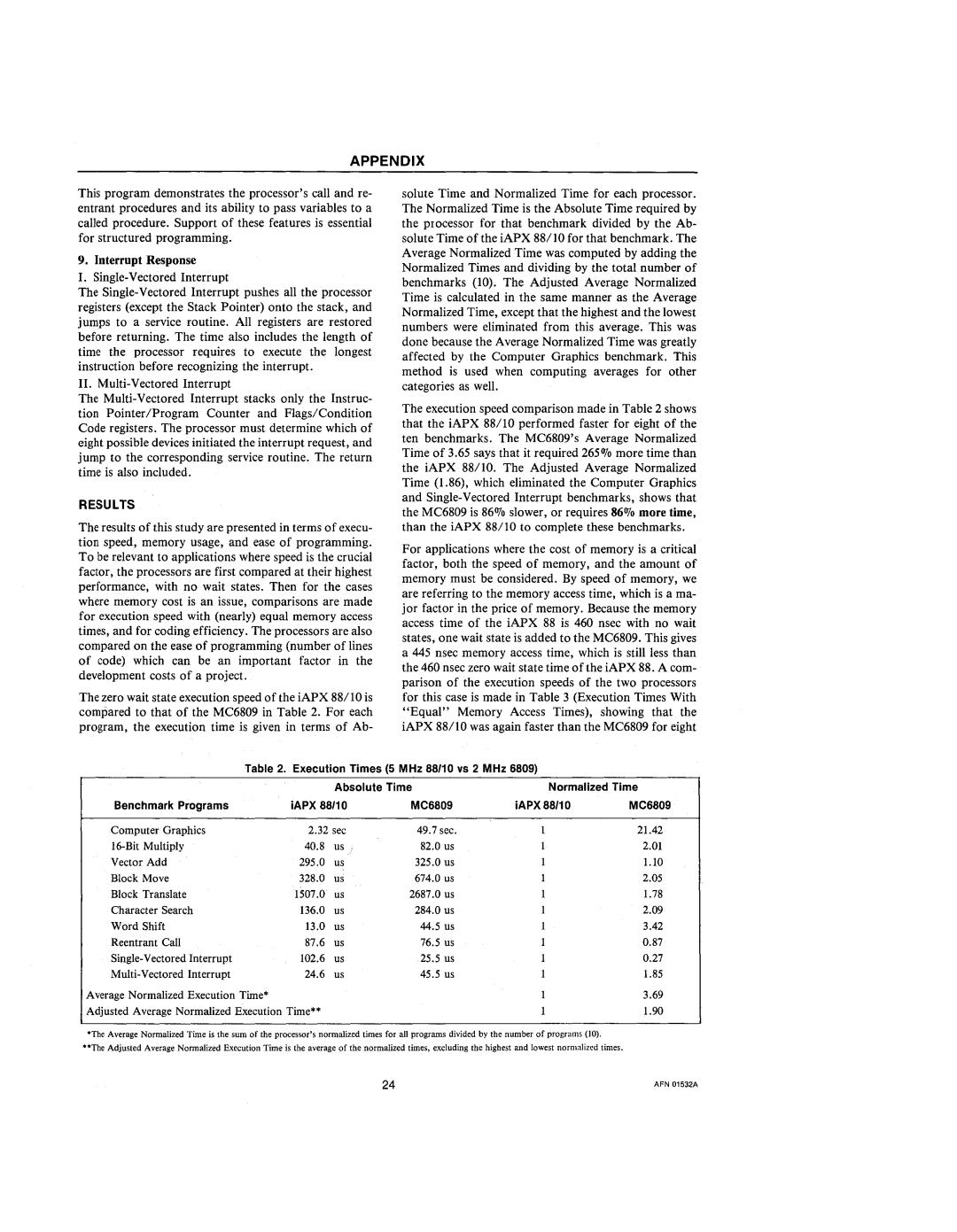
APPENDIX
This program demonstrates the processor's call and re- entrant procedures and its ability to pass variables to a called procedure. Support of these features is essential for structured programming.
9. Interrupt Response
I.
The
II.
The
RESULTS
The results of this study are presented in terms of execu- tion speed, memory usage, and ease of programming. To be relevant to applications where speed is the crucial factor, the processors are first compared at their highest performance, with no wait states. Then for the cases where memory cost is an issue, comparisons are made for execution speed with (nearly) equal memory access times, and for coding efficiency. The processors are also compared on the ease of programming (number of lines of code) which can be an important factor in the development costs of a project.
The zero wait state execution speed of the iAPX 88/10 is compared to that of the MC6809 in Table 2. For. each program, the execution time is given in terms of Ab-
solute Time and Normalized Time for each processor. The Normalized Time is the Absolute Time required by the pIOcessor for that benchmark divided by the Ab- solute Time ofthe iAPX 88/10 for that benchmark. The Average Normalized Time was computed by adding the Normalized Times and dividing by the total number of benchmarks (10). The Adjusted Average Normalized Time is calculated in the same manner as the Average Normalized Time, except that the highest and the lowest numbers were eliminated from this average. This was done because the Average Normalized Time was greatly affected by the Computer Graphics benchmark. This method is used when computing averages for other categories as well.
The execution speed comparison made in Table 2 shows that the iAPX 88/10 performed faster for eight of the ten benchmarks. The MC6809's Average Normalized Time of 3.65 says that it required 2651110 more time than the iAPX 88/10. The Adjusted Average Normalized Time (1.86), which eliminated the Computer Graphics and
For applications where the cost of memory is a critical factor, both the speed of memory, and the amount of memory must be considered. By speed of memory, we are referring to the memory access time, which is a ma- jor factor in the price of memory. Because the memory access time of the iAPX 88 is 460 nsec with no wait states, one wait state is added to the MC6809. This gives a 445 nsec memory access time, which is still less than the 460 nsec zero wait state time of the iAPX 88. A com- parison of the execution speeds of the two processors for this case is made in Table 3 (Execution Times With "Equal" Memory Access Times), showing that the iAPX 88/10 was again faster than the MC6809 for eight
| Table 2. Execution Times (5 MHz 88/10 vs 2 MHz 6809) |
| ||||
|
| Absolute Time |
| Normalized Time | ||
Benchmark Programs | iAPX 88/10 | MC6809 | iAPX88/10 | MC6809 | ||
Computer Graphics | 2.32 sec | 49.7 sec. |
| 21.42 | ||
40.8 | us , | 82.0 us |
| 2.01 | ||
Vector Add | 295.0 | J | 325.0 us |
| 1.10 | |
us |
| |||||
Block Move | 328.0 | us | 674.0 us |
| 2.05 | |
Block Translate | 1507.0 | us | 2687.0 us |
| 1.78 | |
Character Search | 136.0 | us | 284.0 us |
| 2.09 | |
Word Shift | 13.0 | us | 44.5 | us |
| 3.42 |
Reentrant Call | 87.6 | us | 76.5 | us |
| 0.87 |
102.6 | us | 25.5 | us |
| 0.27 | |
24.6 | us | 45.5 | us |
| 1.85 | |
Average Normalized Execution Time· |
|
|
|
| 3.69 | |
Adjusted Average Normalized E~ecution Time·· |
|
|
|
| 1.90 | |
*The Average Normalized Time is the sum of the processor"s nonnalized times for all programs divided by the number of programs (10). "The Adjusted Average Normalized Execution Time is the average of the normalized times, excluding the highest and lowest normalized times.
24 | AFN 01532A |
